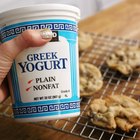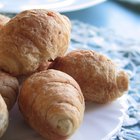
Mrs. Ruth Graves Wakefield, owner of the Toll House Inn in Whitman, Mass., invented the chocolate chip cookie in the 1930s, which began the mission for creating a cookie with the perfect texture, flavor and consistency that continues to this day. Cooks attain a soft, chewy texture with a fine balance of ingredients and baking methods. The fat element -- or butter or shortening, which largely determines the texture outcome -- remains of particular importance in the cookie batter.
Significance
Some cookies come out softer than others almost exclusively because of the butter and shortening ingredients in the batter. They determine the stiffness of the batter, which holds it in place and prevents it from flattening on the cookie sheet. Flat batter during cooking leads to browning around the edges. They become stiff within a matter of hours of removal from the oven.
Butter vs. Shortening
Many cookie recipes call for either butter or shortening, but the best ones, according to food columnist Kathleen Purvis of "The Seattle Times," include both. Shortening maintains the form of the cookie batter, which prevents it from spreading, drying out and becoming overly crispy. Butter softens the flavor of shortening, giving the cookie a natural flavor.
Considerations
Use the yellow, butter-flavored shortening in combination with butter instead of the white, standard type to improve the overall cookie flavor. Look for unhydrogenated shortening, a healthier option compared with a standard grocery-store brand because it does not contain trans fats. Avoid trans fats because they contribute to the development of cardiovascular disease.
Tips
Chilling the cookie batter prior to scooping it onto a cookie sheet remains essential for maintaining a rounder shape in the oven, which prevents it from drying. Use an ice cream scoop to dole out high, round cookie batter portions, which also maintains the shape. Use more than one cookie sheet or cool them between batches to avoid melting the batter too early in the cooking process.
Related Articles

What Causes Cupcakes to Be Dry?

Can You Make Tiramisu With Margherite ...

Substitutes for Butter When Baking ...

How to Substitute Applesauce for Oil in ...

How to Replace Butter With Greek Yogurt ...

Can Humidity Affect Cookies?

Can You Grease a Pan With Canola Oil?

What Is the Difference Between Scones & ...

What is the Origin of the Croissant?

How to Make Scones

Does Canola Oil Taste the Same as ...

Does Baking Soda Affect the Height of a ...

How to Fry Brownies

Does Unbleached Bread Flour Make ...

How Long Do You Bake Brownie Cupcakes ...

Can You Use Applesauce in Place of ...

What Is the Highest Quality Butter for ...

How to Make Cornbread in a Cast-Iron ...

How to Make Shiny Icing for Cookies ...

What Kind of Flour to Use for Cupcakes?
References
- O Chef: What is the Secret to Soft (Mrs.-Field-Like) Cookies?
- "Cook's Illustrated"; Can You Use Butter in Place of Shortening in Pie Crust?; April 2004
- "The New Food Lover's Companion"; Sharon Tyler Herbst, et al.; 2007
Writer Bio
Based in Richmond, Va., Tara Carson has written articles for editorial and corporate online and print publications for more than 10 years. She has experience as an adjunct professor of nutrition at Northwest Christian University and holds a Bachelor of Science in journalism and nutrition from Virginia Commonwealth University.
Photo Credits
Jupiterimages/Comstock/Getty Images